Abstract
Three adult subjects were taught a set of two-choice simultaneous discriminations, with three positive and three negative stimuli; all possible combinations of positive and negative stimuli yielded nine different pairs. The discriminations were repeatedly reversed and rereversed, the former positive stimuli becoming negative and the former negative stimuli becoming positive. With all subjects, a reversal of the contingencies for one pair of stimuli became sufficient to change their responses to all of the other pairs. The reversals had produced functional stimulus classes. Then, all subjects showed conditional discriminations emerging between members of a functional class; given a sample from one class and comparisons from both classes, they selected the comparison that was in the same class as the sample. Next, 2 of the subjects showed that the within-class conditional relations possessed the symmetric and transitive properties of equivalence relations; after having been taught to relate new stimuli to existing class members, the subjects then matched other class members to the new stimuli. Subsequent tests of two-choice discriminations showed that the conditional discriminations had transferred functional class membership to the new stimuli. The 3rd subject, who did not show equivalence relations among functional class members, was also found to have lost the within-class conditional relations after the equivalence tests.
Keywords: equivalence relations, functional equivalence, conditional discrimination, discrimination, matching to sample, humans
Full text
PDF





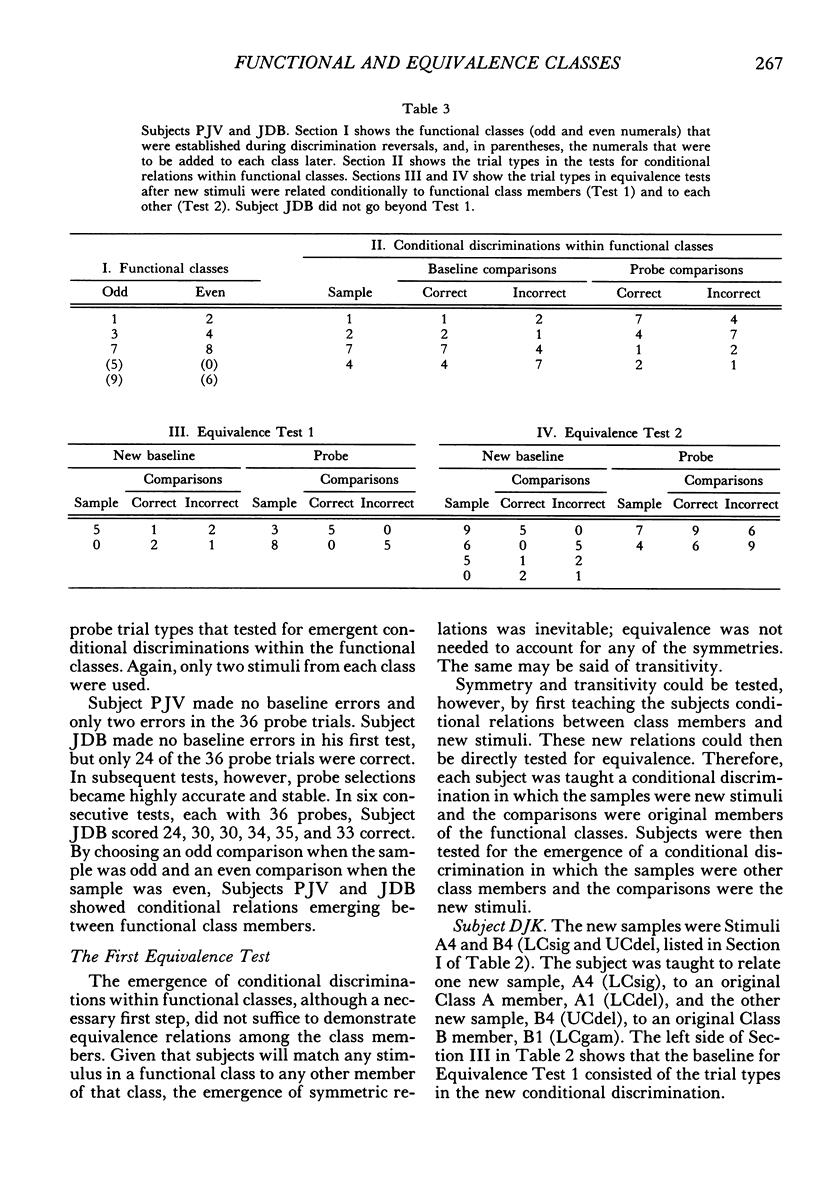
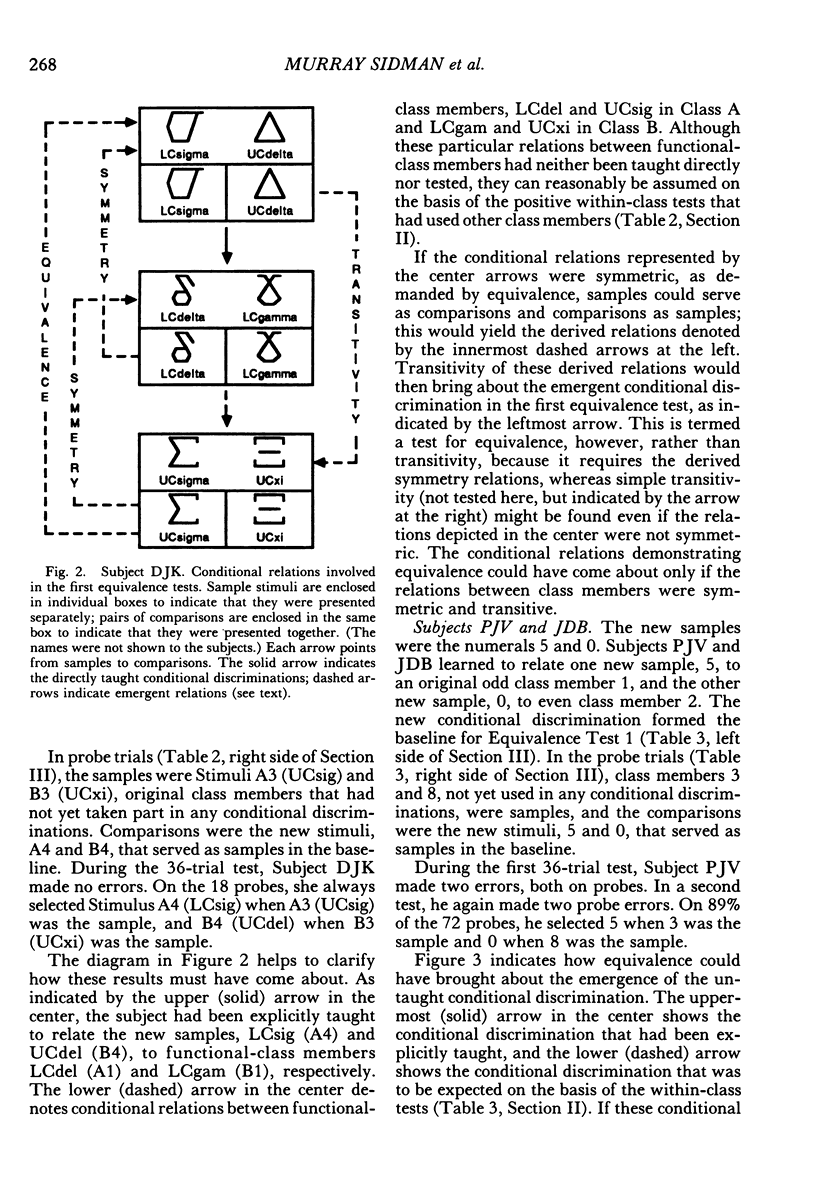

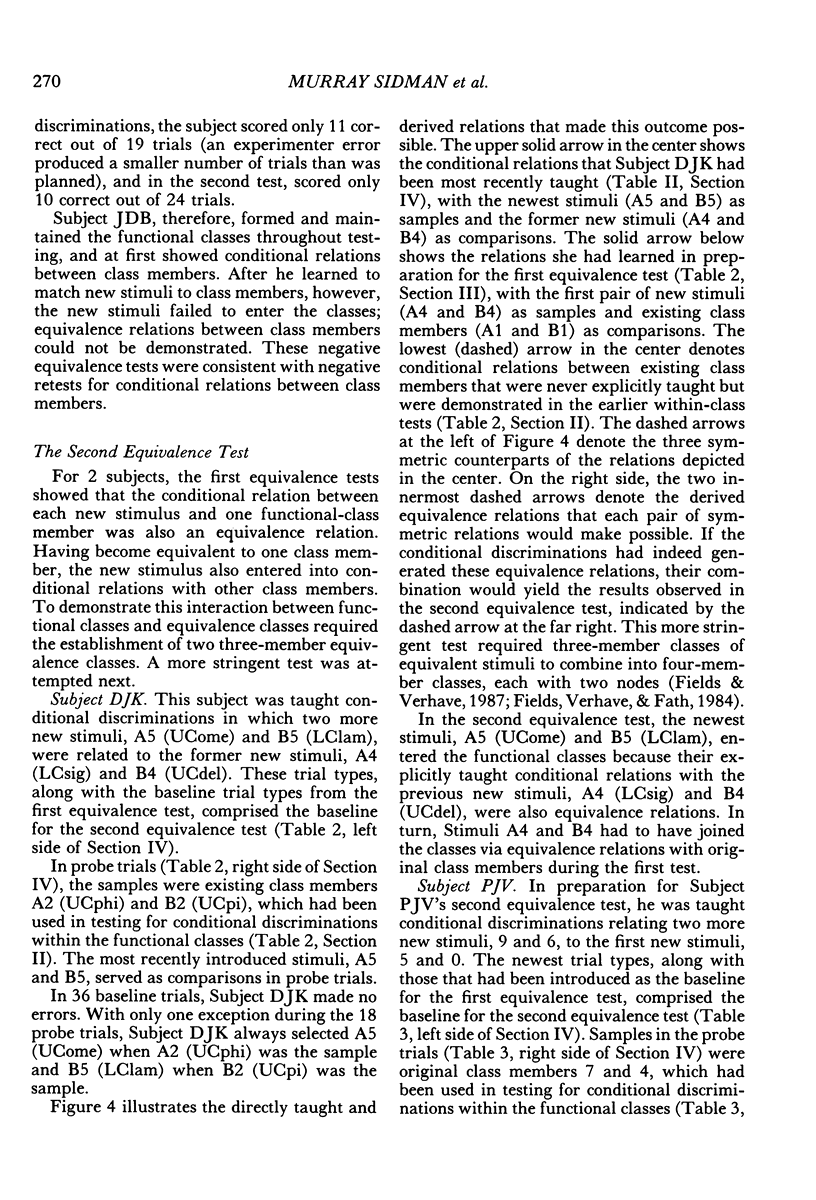
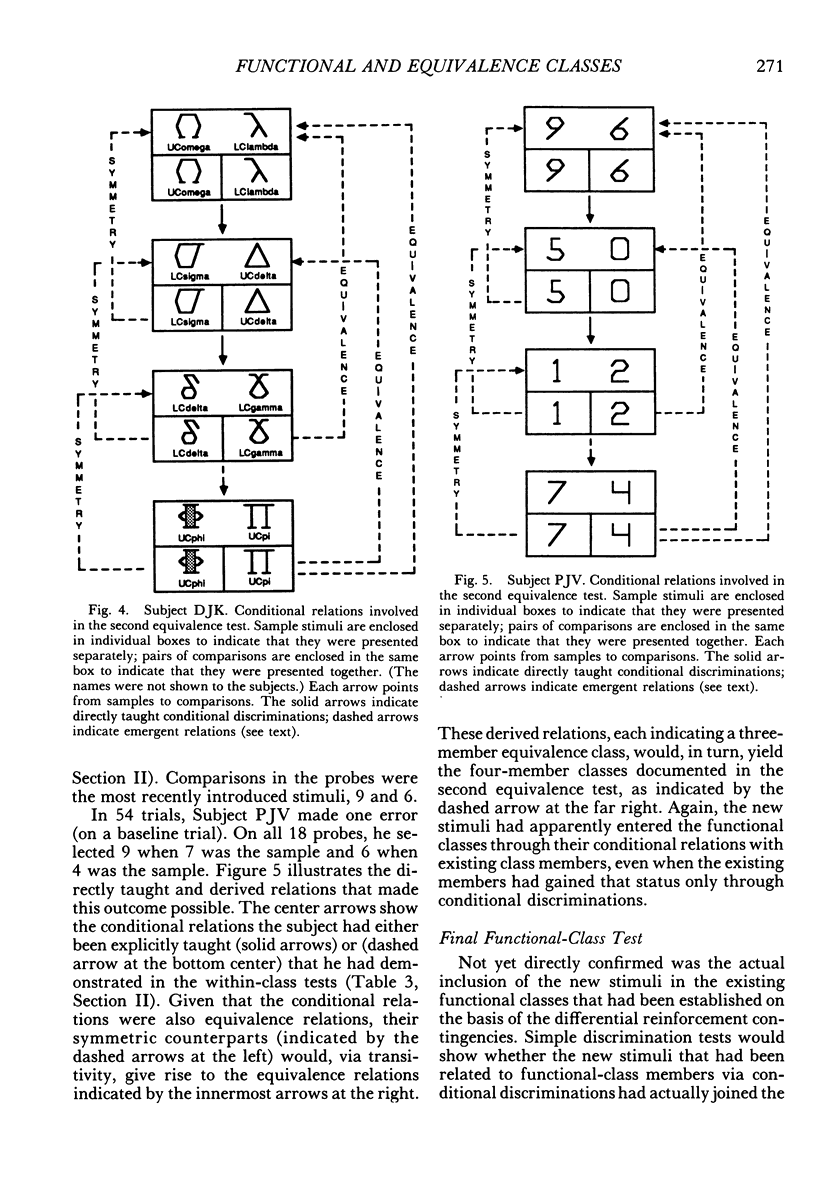

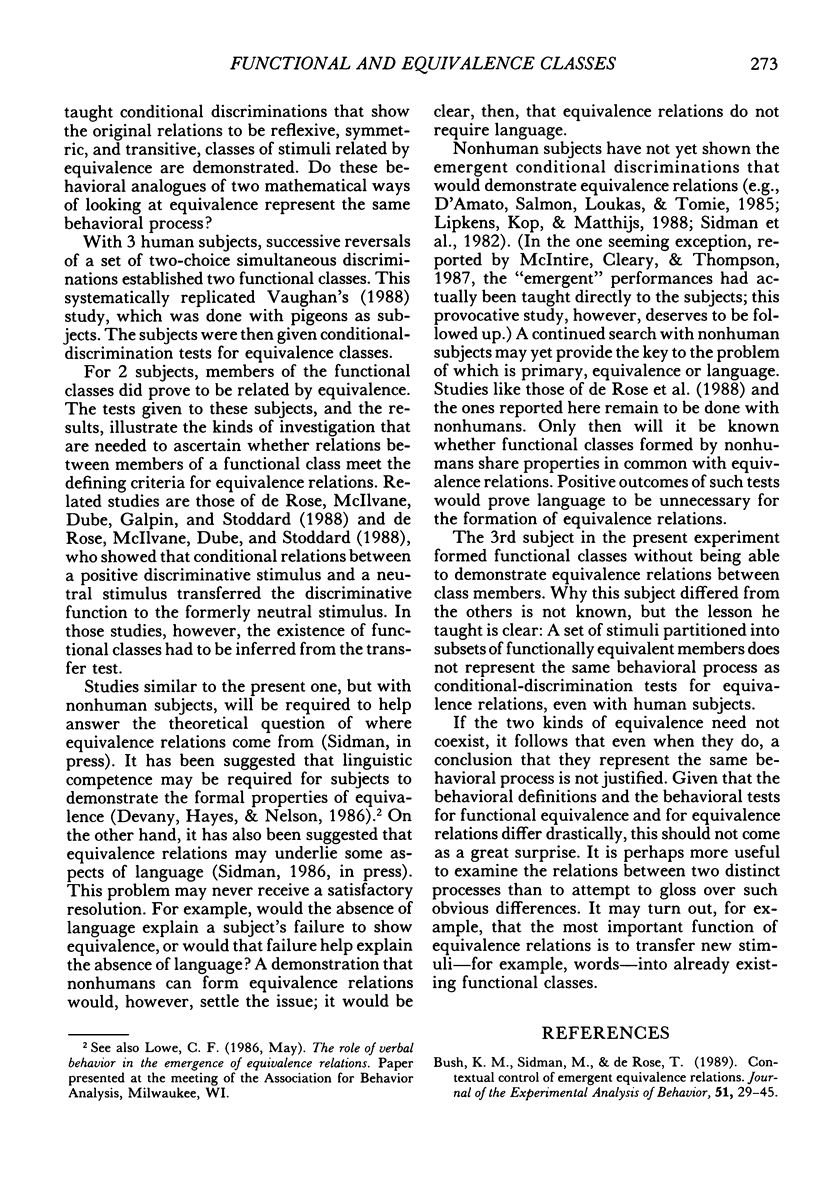

Selected References
These references are in PubMed. This may not be the complete list of references from this article.
- Bush K. M., Sidman M., de Rose T. Contextual control of emergent equivalence relations. J Exp Anal Behav. 1989 Jan;51(1):29–45. doi: 10.1901/jeab.1989.51-29. [DOI] [PMC free article] [PubMed] [Google Scholar]
- D'Amato M. R., Salmon D. P., Loukas E., Tomie A. Symmetry and transitivity of conditional relations in monkeys (Cebus apella) and pigeons (Columba livia). J Exp Anal Behav. 1985 Jul;44(1):35–47. doi: 10.1901/jeab.1985.44-35. [DOI] [PMC free article] [PubMed] [Google Scholar]
- Devany J. M., Hayes S. C., Nelson R. O. Equivalence class formation in language-able and language-disabled children. J Exp Anal Behav. 1986 Nov;46(3):243–257. doi: 10.1901/jeab.1986.46-243. [DOI] [PMC free article] [PubMed] [Google Scholar]
- Fields L., Verhave T., Fath S. Stimulus equivalence and transitive associations: A methodological analysis. J Exp Anal Behav. 1984 Jul;42(1):143–157. doi: 10.1901/jeab.1984.42-143. [DOI] [PMC free article] [PubMed] [Google Scholar]
- Fields L., Verhave T. The structure of equivalence classes. J Exp Anal Behav. 1987 Sep;48(2):317–332. doi: 10.1901/jeab.1987.48-317. [DOI] [PMC free article] [PubMed] [Google Scholar]
- Lazar R. Extending sequence-class membership with matching to sample. J Exp Anal Behav. 1977 Mar;27(2):381–392. doi: 10.1901/jeab.1977.27-381. [DOI] [PMC free article] [PubMed] [Google Scholar]
- Lipkens R., Kop P. F., Matthijs W. A test of symmetry and transitivity in the conditional discrimination performances of pigeons. J Exp Anal Behav. 1988 May;49(3):395–409. doi: 10.1901/jeab.1988.49-395. [DOI] [PMC free article] [PubMed] [Google Scholar]
- McIntire K. D., Cleary J., Thompson T. Conditional relations by monkeys: Reflexivity, symmetry, and transitivity. J Exp Anal Behav. 1987 May;47(3):279–285. doi: 10.1901/jeab.1987.47-279. [DOI] [PMC free article] [PubMed] [Google Scholar]
- Sidman M., Kirk B., Willson-Morris M. Six-member stimulus classes generated by conditional-discrimination procedures. J Exp Anal Behav. 1985 Jan;43(1):21–42. doi: 10.1901/jeab.1985.43-21. [DOI] [PMC free article] [PubMed] [Google Scholar]
- Sidman M., Rauzin R., Lazar R., Cunningham S., Tailby W., Carrigan P. A search for symmetry in the conditional discriminations of rhesus monkeys, baboons, and children. J Exp Anal Behav. 1982 Jan;37(1):23–44. doi: 10.1901/jeab.1982.37-23. [DOI] [PMC free article] [PubMed] [Google Scholar]
- Sidman M. Reading and auditory-visual equivalences. J Speech Hear Res. 1971 Mar;14(1):5–13. doi: 10.1044/jshr.1401.05. [DOI] [PubMed] [Google Scholar]
- Sidman M., Tailby W. Conditional discrimination vs. matching to sample: an expansion of the testing paradigm. J Exp Anal Behav. 1982 Jan;37(1):5–22. doi: 10.1901/jeab.1982.37-5. [DOI] [PMC free article] [PubMed] [Google Scholar]
- Spradlin J. E., Cotter V. W., Baxley N. Establishing a conditional discrimination without direct training: a study of transfer with retarded adolescents. Am J Ment Defic. 1973 Mar;77(5):556–566. [PubMed] [Google Scholar]
- Touchette P. E. Transfer of stimulus control: measuring the moment of transfer. J Exp Anal Behav. 1971 May;15(3):347–354. doi: 10.1901/jeab.1971.15-347. [DOI] [PMC free article] [PubMed] [Google Scholar]
- Wulfert E., Hayes S. C. Transfer of a conditional ordering response through conditional equivalence classes. J Exp Anal Behav. 1988 Sep;50(2):125–144. doi: 10.1901/jeab.1988.50-125. [DOI] [PMC free article] [PubMed] [Google Scholar]
- de Rose J. C., McIlvane W. J., Dube W. V., Galpin V. C., Stoddard L. T. Emergent simple discrimination established by indirect relation to differential consequences. J Exp Anal Behav. 1988 Jul;50(1):1–20. doi: 10.1901/jeab.1988.50-1. [DOI] [PMC free article] [PubMed] [Google Scholar]


